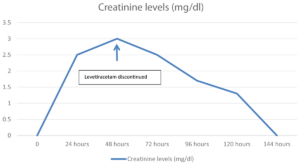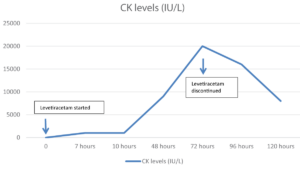Levetiracetam-induced Rhabdomyolysis – A Rare Complication
A Rare Case of Levetiracetam-Induced Rhabdomyolysis
Neurology, the study of the nervous system, consistently uncovers new insights into the effects of drugs on brain and body health. Among the medications used for epilepsy management, levetiracetam is a widely prescribed antiepileptic agent, celebrated for its efficacy and safety profile. However, rare complications such as rhabdomyolysis reveal the importance of comprehensive monitoring. This blog post explores a documented case of levetiracetam-induced rhabdomyolysis, highlighting its clinical presentation, management, and implications for the field of Neurology.
For more details, refer to the HTML article or download the PDF version.
Understanding Levetiracetam and Rhabdomyolysis
- Levetiracetam Overview:
Levetiracetam is an antiepileptic drug used for generalized and focal-onset seizures. It acts by modulating neurotransmitter release through binding to synaptic vesicle protein 2A. Although generally well-tolerated, rare side effects like rhabdomyolysis warrant attention. - What is Rhabdomyolysis?
Rhabdomyolysis involves the breakdown of muscle tissue, leading to the release of muscle components (e.g., creatine kinase [CK], myoglobin) into the bloodstream. Symptoms range from asymptomatic CK elevation to severe complications like acute kidney injury (AKI) and electrolyte imbalances. Figure 1: Creatinine level trend in association with levetiracetam use.
Figure 1: Creatinine level trend in association with levetiracetam use.
Figure 2: CK level trend in association with levetiracetam use.
Case Report: A Rare Neurological Challenge
Patient Background
A 20-year-old male with epilepsy presented after a seizure episode. He was previously prescribed levetiracetam but was non-compliant. Following administration of a 1-gram loading dose of levetiracetam in the emergency department, the patient exhibited raised CK levels and acute kidney injury.
Clinical Observations
- Initial Symptoms: Post-seizure confusion, myalgias, and CK elevation (1219 IU/L, normal range: 46–171).
- Peak CK Levels: CK levels spiked to 19,757 IU/L within 72 hours of levetiracetam initiation.
Management and Outcome
- Levetiracetam was discontinued, and the patient was switched to lamotrigine.
- Aggressive hydration and kidney monitoring were implemented.
- CK and creatinine levels normalized within 48 hours post-discontinuation.
Mechanism Behind the Complication
Although the exact mechanism of levetiracetam-induced rhabdomyolysis remains unclear, theories suggest that the drug’s interaction with synaptic vesicle protein 2A in motor neurons may exacerbate muscle stress and breakdown. This underscores the need for vigilance in managing antiepileptic therapies.
Clinical Implications in Neurology
- Routine Monitoring:
- CK and creatinine levels should be monitored in patients receiving levetiracetam, especially those presenting with muscle pain or weakness.
- Early detection can prevent severe outcomes like AKI.
- Switching Medications:
- Neurologists should consider alternative antiepileptics like lamotrigine when complications arise.
- Raising Awareness:
- With fewer than 20 cases of levetiracetam-induced rhabdomyolysis reported globally, this rare complication highlights the importance of reporting and studying adverse drug reactions in Neurology.
Conclusion
This case of levetiracetam-induced rhabdomyolysis sheds light on the rare but severe complications of antiepileptic drug therapy. Neurologists and healthcare professionals must remain vigilant in monitoring and managing such adverse effects to ensure patient safety.
For the full case details, visit the HTML article or read the PDF version.
FAQs
- What is levetiracetam, and what is it used for?
Levetiracetam is an antiepileptic drug used to treat generalized and focal-onset seizures. It modulates synaptic neurotransmitter release by binding to synaptic vesicle protein 2A, making it effective for seizure management. - What is rhabdomyolysis, and how is it related to levetiracetam?
Rhabdomyolysis is a condition involving muscle breakdown, releasing components like creatine kinase (CK) into the bloodstream. While rare, levetiracetam can induce rhabdomyolysis by potentially affecting motor neurons and increasing muscle stress. - What are the symptoms of levetiracetam-induced rhabdomyolysis?
Symptoms include elevated CK levels, muscle pain (myalgia), acute kidney injury, and fatigue. However, it can also present asymptomatically with only elevated CK levels as an indicator. - How is levetiracetam-induced rhabdomyolysis managed?
Management includes discontinuing levetiracetam, switching to an alternative antiepileptic drug (e.g., lamotrigine), and aggressive intravenous hydration to prevent kidney damage. Monitoring CK and creatinine levels is essential. - How common is rhabdomyolysis as a side effect of levetiracetam?
Rhabdomyolysis is extremely rare, with fewer than 20 cases reported globally. Despite its rarity, awareness and monitoring are crucial to manage this potentially life-threatening complication
